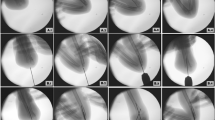Abstract
In this study we compared the results of patients with displaced supracondylar humeral fractures who had been treated with all lateral cross-wire and medio-lateral cross-wire fixation techniques. Only the 139 patients who were able to attend the final examination were included in the assessment. The patients were allocated retrospectively into two groups according to the pin configuration used. Group 1 comprised 75 patients, 60 male and 15 female, with a mean age of 7.5 years (range, 1.5–14 years). After closed reduction, fixation was achieved with crossed K-wires placed from the lateral condyle and lateral humerus towards the medial epicondyle. Care was taken so that the end of the K-wire passing from the lateral humerus did not protrude excessively at the level of the medial epicondyle. Group 2 comprised 64 patients, 54 males and ten females, with a mean age of 7.8 years (range, 2–13 years). After closed reduction, two cross-wires passed—one from medial and one from lateral. In group 1 there was no postoperative iatrogenic nerve damage whereas in group 2 iatrogenic ulnar nerve damage developed in six (9%) patients. On statistical evaluation, a significant difference was seen between the two groups. According to Flynn’s criteria, there was no statistically significant difference between the two groups. In conclusion, the lateral cross-wire fixation technique may be a good choice in the treatment of paediatric supracondylar humerus fractures as it reduces the possibility of ulnar nerve damage and achieves the same level of stabilisation as medio-lateral fixation.


Similar content being viewed by others
References
Cheng JC, Lam TP, Shen WY (1995) Closed reduction and percutaneous pinning for type III displaced supracondylar fractures of the humerus in children. J Orthop Trauma 9:511–515
Davis R, Gorczyca J, Pugh K (2000) Supracondylar humerus fractures in children. Comparison of operative treatment methods. Clin Orthop Relat Res 376:49–55
El-Adl WA, El-Said MA, Boghaday GW et al (2008) Results of treatment of displaced supracondylar humeral fractures in children by percutaneous lateral cross-wiring technique. Strategies Trauma Limb Reconstr 3:1–7
Flynn JC, Matthews JG, Benoit RL (1974) Blind pinning of displaced supracondylar fractures of the humerus in children. Sixteen years’ experience with long term follow-up. J Bone Jt Surg Am 56:263–272
Gordon JE, Patton CM, Luhmann SJ et al (2001) Fracture stability after pinning of displaced supracondylar distal humerus fractures in children. J Pediatr Orthop 21:313–318
Kuo CE, Widmann RF (2004) Reduction and percutaneous pin fixation of displaced supracondylar elbow fractures in children. Tech Shoulder Elbow Surg 5:90–102
Lee SS, Mahar AT, Miesen D et al (2002) Displaced pediatric supracondylar humerus fractures: biomechanical analysis of percutaneous pinning techniques. J Pediatr Orthop 22:440–443
Lyons JP, Ashley E, Hoffer MM (1998) Ulnar nerve palsies after percutaneous cross-pinning of supracondylar fractures in children’s elbows. J Pediatr Orthop 18:43–45
Mehlman CT, Crawford AH, McMillion TL et al (1996) Operative treatment of supracondylar fractures of the humerus in children: the Cincinnati experience. Acta Orthop Belg 62(Suppl 1):41–50
Mehlman CT, Strub WM, Roy DR et al (2001) The effect of surgical timing on the perioperative complications of treatment of supracondylar humeral fractures in children. J Bone Joint Surg Am 83:323–327
Reitman RD, Waters P, Millis M (2001) Open reduction and internal fixation for supracondylar humerus fractures in children. J Pediatr Orthop 21:157–161
Royce RO, Dutkowsky JP, Kesser JR et al (1991) Neurologic complications after K-wire fixation of supracondylar humerus fractures in children. J Pediatr Orthop 11:191–194
Shannon FJ, Mohan P, Chacko J et al (2004) "Dorgan’s" percutaneous lateral cross-wiring of supracondylar fractures of the humerus in children. J Pediatr Orthop 24:376–379
Skaggs DL, Hale JM, Basset J et al (2001) Operative treatment of supracondylar fractures of the humerus in children. The consequences of pin placement. J Bone Jt Surg Am 83:735–740
Wind WM, Schwend RM, Armstrong DG (2002) Predicting ulnar nerve location in pinning of supracondylar humerus fractures. J Pediatr Orthop 22:444–447
Zionts LE, McKellop HA, Hathaway R (1994) Torsional strength of pin configurations used to fix supracondylar fractures of the humerus in children. J Bone Joint Surg Am 76:253–256
Conflict of interest statement
The authors did not receive any grants or outside funding in support of their research or preparation of this manuscript. The authors did not have any financial and personal relationships with other people or organisations that could inappropriately influence (bias) their work.
Author information
Authors and Affiliations
Corresponding author
Rights and permissions
About this article
Cite this article
Memisoglu, K., Cevdet Kesemenli, C. & Atmaca, H. Does the technique of lateral cross-wiring (Dorgan’s technique) reduce iatrogenic ulnar nerve injury?. International Orthopaedics (SICOT) 35, 375–378 (2011). https://doi.org/10.1007/s00264-010-1090-9
Received:
Revised:
Accepted:
Published:
Issue Date:
DOI: https://doi.org/10.1007/s00264-010-1090-9




